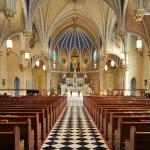Everybody knows that Halloween is just the baptized pagan feast of Samhain, right?
Everybody’s wrong. Here: have some actual history, courtesy of Yr. Obdt. Svt.:
One game some postmodern people never tire of is attempting to shock Catholics with the news that something or other regarding the Faith is really just warmed-over paganism. (Though curiously, one never hears that people who say “Today is Thursday” are worshipers of Thor.) And a favorite claim among such folk is the old chestnut (never realized by them to be an old chestnut) that Halloween is really druidry that got unsuccessfully suppressed and transmogrified by the Church.
Now, it’s true that the ancient Celts of the British Isles had a little festival on Oct. 31. But this was much as Americans mark Arbor Day on their calendars without it occupying a lot of psychological space in their consciousness. In short, it wasn’t that big of a deal to ancient Celts.
More than that, Halloween is called that because it is the vigil of the feast of All Saints or “All Hallows.” But that feast was not founded to accommodate British Celts; it was founded for Roman Christians. The problem was Italian logistics, not “How do we get the Druids on board?” The Church by the seventh century was swimming in martyrs and saints, popular in various locales. If we celebrated all their feast days, nobody would get any work done. Solution: have a feast to celebrate all the saints popular in different Italian towns and villages all at once.
Feast of All Saints
“Yes,” says the Wiccan, “and so they picked our feast of Samhain to co-opt us!”
Actually, no. All Saints was originally celebrated on May 13, but Pope Gregory III (d. 741) moved it to Nov. 1, the dedication day of All Saints Chapel at St. Peter’s in Rome. Notice that the All Saints Chapel is a considerable distance from the nearest Druid cult in the British Isles. Also notice that Gregory could not have cared less what the few remaining Celts might think about that — particularly because the feast was local to Rome and its environs and had nothing whatsoever to do with the British Isles.
It was not until a century later, in the 840s, that Pope Gregory IV commanded All Saints to be observed everywhere. And so the holy day (finally!) spread to Ireland. And by that time, Ireland had already been thoroughly Christian for a very long while, given that St. Patrick, the apostle to Ireland, had died three centuries before.












